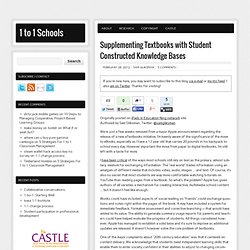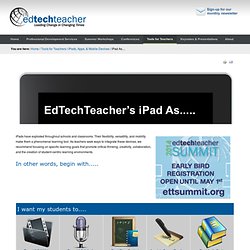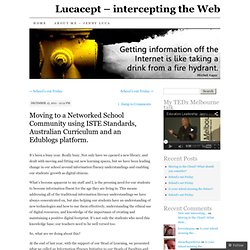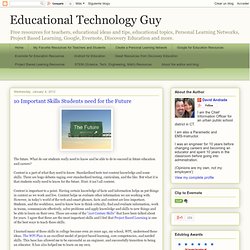

20 Must-Have Educational Resources For All Teachers. Edudemic often features posts providing a list of top resources for a particular category. Recently, the site gettingsmart.com posted the names of the LAUNCHedu finalists chosen by the SXSWedu® Conference, offering even more resources for the Edudemic staff to consider! On March 7, 2012, they will choose winners after a full day of presentations by the finalists. There are so many sites and programs on the Internet already, but this competition just goes to show that the need for educational resources is still great. Necessity is the mother of invention, they say. The cliche works because it is true. I thought and pondered, considered and reconsidered, and researched and revised a list in my head this week. First, however, I created a wordle using some of the lists the editors have created recently. I divided my resources into categories, based on my interests as a teacher. Devices iPad – The iPad provides access to e-texts and incredible educational apps.
Resources for Lesson Planning. A day in the future – the vision and the story. TeachersFirst: The web resource by teachers, for teachers. Reimagining the classroom to meet the needs of every student. Supplementing Textbooks with Student Constructed Knowledge Bases. Originally posted on iPads in Education Ning network site Authored by Sam Gliksman, Twitter: @samgliksman We’re just a few weeks removed from a major Apple announcement regarding the release of a new eTextbooks initiative.

I’m keenly aware of the significance of the move to eBooks, especially as I have a 13 year old that carries 20 pounds in his backpack to school every day. However important the move from paper to digital textbooks, I’m still left with a taste for more. I have been critical of the ways most schools still rely on text as the primary, almost solitary, medium for exchanging information. The “real world” trades information using an amalgam of different media that includes video, audio, images … and text. iBooks could have included aspects of social reading so “friends” could exchange questions and notes right within the pages of the book. Instead we could prioritize “content construction”. Organizing Content Social Bookmarking. ANNOTEXTING - Amherst, NY. Cell Phones as Teaching Tools: 26 Places You'll Find Resources and Lesson Plans.
iPad As.... iPads have exploded throughout schools and classrooms.

Their flexibility, versatility, and mobility make them a phenomenal learning tool. As teachers seek ways to integrate these devices, we recommend focusing on specific learning goals that promote critical-thinking, creativity, collaboration, and the creation of student-centric learning environments. Moving to a Networked School Community using ISTE Standards, Australian Curriculum and an Edublogs platform. It’s been a busy year.

Really busy. Not only have we opened a new library, and dealt with moving and fitting out new learning spaces, but we have been leading change in our school around information fluency understandings and enabling our students’ growth as digital citizens. What’s become apparent to my staff and I, is the pressing need for our students to become information fluent for the age they are living in. This means addressing all of the traditional information literacy understandings we have always concentrated on, but also helping our students have an understanding of new technologies and how to use them effectively, understanding the ethical use of digital resources, and knowledge of the importance of creating and maintaining a positive digital footprint. Move Over Three R’s, Here Come the Three C’s. - 10 Tech Skills Every Student Should Have. 10 Important Skills Students need for the Future. The future.

What do our students really need to know and be able to do to succeed in future education and careers? Content is a part of what they need to know. Standardized tests test content knowledge and some skills. There are huge debates raging over standardized testing, curriculum, and the like. But what it is that students really need to know for the future. Content is important to a point. I learned many of these skills in college because even 20 years ago, my school, WPI, understood these ideas. Research by the Institute for the Future released in a report entitled “Future Work Skills 2020″ shows that preparing for a specific career area based on content is difficult and, instead, people should be developing certain broad skills.
Here are the skills: Sense-making. Social intelligence. Novel and adaptive thinking. Cross-cultural competency. Computational thinking. New-media literacy. Transdisciplinarity. Cognitive load management. Virtual collaboration. The 100 Best Web 2.0 Classroom Tools Chosen By You. The Wordle of this list! (Click image to enlarge) One of the most popular posts on Edudemic in 2010 was The 35 Best Web 2.0 Classroom Tools Chosen By You and I felt it might be time for an update to that list for 2011. In order to put together a list of the best Web 2.0 classroom tools, I polled my Twitter followers, Facebook fans (are they still called fans? Likes?)